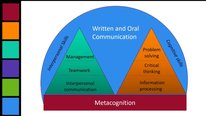- Robert Hilborn
- http://www.aapt.org/aboutaapt/organization/Robert_Hilborn_Bio.cfm
- Associate Executive Officer
- Presenter’s NSFRESOURCECENTERS
- American Association of Physics Teachers, American Physical Society, American Astronomical Society
- Stephanie Chasteen
- http://www.sciencegeekgirl.com/bio.html
- Presenter’s NSFRESOURCECENTERS
- sciencegeekgirl enterprises LLC, University of Colorado Boulder
- Sarah ("Sam") McKagan
- http://www.aapt.org/aboutaapt/SMcKagan_DSC_pr20120926.cfm
- Presenter’s NSFRESOURCECENTERS
- American Association of Physics Teachers, PhysPort
Physics and Astronomy New and Experienced Faculty Workshops
NSF Awards: 1431681
2015 (see original presentation & discussion)
Undergraduate, Graduate
The Physics and Astronomy New and Experienced Faculty Workshops provide introductions to research-based interactive engagement pedagogical methods and the evidence for the effectiveness of those methods, all within the broader context of faculty professional development. The project now reaches about 50% of the new tenure-track hires in physics and astronomy in the U.S.
Science, PD Models
AAPT, APS Physics, AAS
NSF Scholarships in Science, Technology, Engineering, and Mathematics Program (S-STEM), Improving Undergraduate STEM Education (IUSE)
Related Content for Physics and Astronomy New and Experienced Faculty Workshops
-
 2018Cal-Bridge: Changing the face of STEM, one student at a time
2018Cal-Bridge: Changing the face of STEM, one student at a time
Alexander Rudolph
-
 2021IBL Workshops Work!
2021IBL Workshops Work!
Stan Yoshinobu
-
 2018How Can We Help Students Succeed in College Math Courses?
2018How Can We Help Students Succeed in College Math Courses?
Stan Yoshinobu
-
 2020Enhancing Learning by Improving Process Skills in STEM
2020Enhancing Learning by Improving Process Skills in STEM
Renee Cole
-
 2021One-on-one mentoring model for engineering students at a MSI
2021One-on-one mentoring model for engineering students at a MSI
Paola Bandini
-
 2019TRESTLE: A Network Approach to Improving STEM Education
2019TRESTLE: A Network Approach to Improving STEM Education
Andrea Greenhoot
-
 2020Creating a Coherent Gateway to STEM Teaching and Learning
2020Creating a Coherent Gateway to STEM Teaching and Learning
Melanie Cooper
-
 2018Teaching about Earth for a Sustainable Future: The InTeGrate
2018Teaching about Earth for a Sustainable Future: The InTeGrate
Cathryn Manduca
This video has had approximately 248 visits by 222 visitors from 60 unique locations. It has been played 133 times as of 05/2023.
Map reflects activity with this presentation from the 2015 Teaching & Learning Video Showcase website, as well as the STEM For All Multiplex website. 
Based on periodically updated Google Analytics data. This is intended to show usage trends but may not capture all activity from every visitor.
show more
Discussion from the 2015 Teaching & Learning Video Showcase (12 posts)



Amy Busey
Research Associate
It sounds like your project is making many of the resources and presentations from the workshops available to a virtual audience. What have you found to be the trade-offs, challenges, or affordances associated with virtual participation vs. in-person?
Sarah ("Sam") McKagan
This is a brand new project so we don’t know much yet about how well the virtual version does or does not work. One advantage of the in-person version of the New Faculty Workshop is that participants have set aside three days to be immersed in the experience, so they really make time to get involved. We created an online version because not everyone can make time to attend in person, and we wanted to make these workshops, which have been hugely beneficial to participants, available to a wider audience. I think the biggest challenge we will face is that it’s just much harder for people to motivate themselves to spend an hour watching a presentation if they aren’t there in person, even if they are interested. One way to address this challenge could be to have local groups of faculty who get together in person to watch and discuss these presentations.
Robert Hilborn
Associate Executive Officer
Additionally, we have recently added a Faculty Online Learning Community (FOLC) component to the workshops, with the aim of supplementing and extending the in-person experience. We’re still experimenting with the model, so we can’t say anything about the effectiveness, but it is certainly showing some promise. A lot of research supports the idea of having an intensive, in-person experience that is supplemented by ongoing community involvement. We hope that the videos may at least provide some access to the experience to the broader community, since the workshops themselves have proven so successful.
Kathy Perkins
I’m excited to see this workshop go online – but I can certainly see the challenges to getting folks to devote time to watching the videos!
I am wondering if you think the videos and associated hand-outs/materials will be useful to faculty who participate in person. I know we usually recommend “just try one thing” to begin. The videos could also provide an opportunity for faculty to go back, and revisit a teaching approach when they are ready to try it or when they are moving onto a specific course – like upper division instruction.
I know its perhaps beyond the scope of your project, but what about also providing a 4 minute teaser … that gives some of the basics and then the longer full workshop session with everything?
How are you going to track impact?
Stephanie Chasteen
multimedia director
Great questions, Kathy, thanks! Yes, a large part of the idea of putting the videos online is to give access to people who have attended the workshops. That might even be the most frequent use case. The particular analytics that will be used are best known by our website guru, Sam, but she’s just on her way out of the country and may not be able to weigh in.
CHARLES MATTHEWS
In our project, we have used both in-person and online workshops. Although it is frequently impractical, we have found that on-line PD works best if you can have some (even limited) person-to-person interaction prior to the on-line asynchronous PD. Is it feasible for youo to have such person-to-person interaction prior to the online PD?
Stephanie Chasteen
multimedia director
As we mentioned above, we are also experimenting with Faculty Online Learning Communities (FOLCs), with exactly this idea in mind… that we can leverage the in-person experience to create some good experiences online. Some of the literature on online communities suggests that a “sense of knowing” the others in the community really contributes to having a vital community. We hope that the in-person workshop will give a good base — both for people to know one another, and to have a common set of experiences and knowledge. So far the FOLCs are working well, though we are finding that it’s hard to create cohesion right off the bat with a set of people who were involved in such a large in-person workshop. This year, we will give our FOLC participants a chance to get together during the in-person workshop, so they see each other face to face within their group.
Michelle Perry
Researcher
Am I understanding correctly that the idea is to make videos of the live sessions and associated materials available online? Are there plans to adapt the materials at all to make online use more effective/efficient? Will there be some sort of supports developed for those who choose to view the materials online?
Stephanie Chasteen
multimedia director
This is really a grand experiment, Michelle. We have lots of data and research to show that the online workshops are very effective at raising faculty awareness of alternative teaching strategies, and getting them to try them. We are very curious as to what the use case scenario will be for people using the online videos. Will they have any of that same impact? How much will they be used? Will the videos have high use rates? We felt it was worthwhile to try putting them online, to explore these questions, but since we aren’t so sure of the user scenarios that will lead people to explore the videos, we are not yet sure what supports will be worth putting resources into. We’d be open to suggestions and feedback!
Robert Teese
I am glad you are running this project because I would like 100% of the new faculty to have this experience.
It seems to me that faculty are better able to handle long presentations than students. Nevertheless, they must have some limit to their attention span. Will you edit the presentation videos down to, say, eight to ten-minute segments that will seem easy to digest in a single session?
Stephanie Chasteen
multimedia director
Once we have a sense of the use-case scenarios for these videos, it may be worth the resources to edit the videos to be shorter. I would love to make them into more of an online workshop experience, with interspersed questions, but that would be a larger project.
Robert Hilborn
Associate Executive Officer
Interesting idea but we would have to redo the videos to fit that format. The current workshop sessions involve interactive engagement parts as well as short presentations by the leaders. Nevertheless, we might think of having short segments, each of which then has an engagement piece attached to it.
Further posting is closed as the event has ended.